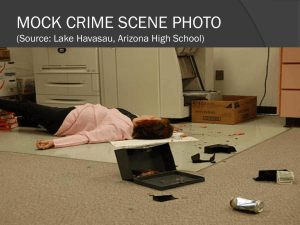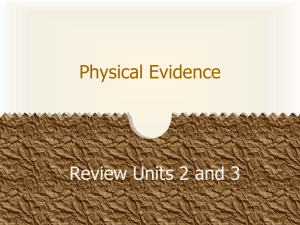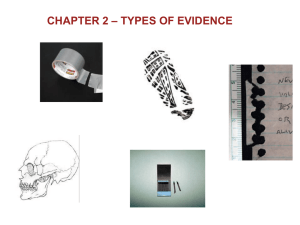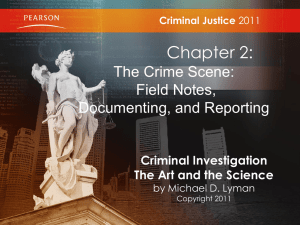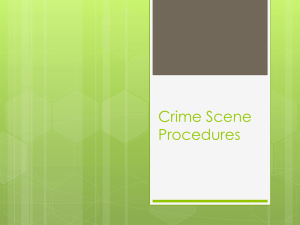The Crime Scene
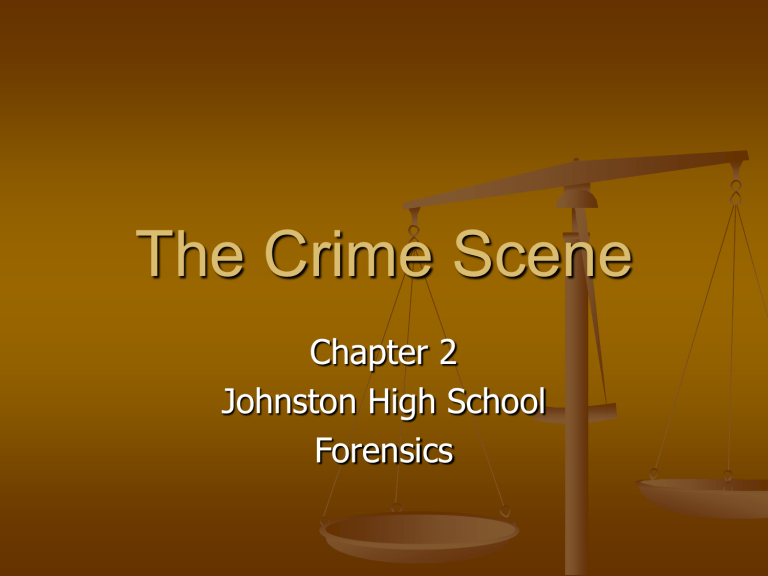
The Crime Scene
Chapter 2
Johnston High School
Forensics
Learning Goals
1)
2)
3)
4)
Define physical evidence
Discuss responsibilities of first officer arriving at scene
Explain steps to be taken to thoroughly record crime scene
Describe proper procedures for conducting systematic search for evidence
More learning goals…
5) Describe proper techniques for packaging common types of physical evidence
6) Define and understand concept of chain of custody
7) Understand contributions of the forensic pathologist, entomologist, and anthropologist can make to a homicide investigation
Physical Evidence
Physical Evidence: Any object that can establish that a crime has been committed or can link a crime to its victim or its perpetrator.
Importance of Evidence
Forensic Science begins at the crime scene!
Scientist must be able to RECOGNIZE evidence
Must be able to COLLECT evidence
Must be able to PRESERVE evidence
Remember…garbage in, garbage out!
Approaching a Crime Scene
Securing and Isolating
Crime Scene
The first officer at the scene must…
1) offer medical assistance when needed and/or make an arrest
2) exclude all unauthorized personnel from scene (very hard!)
3) Call for assistance/backup
4) isolate area (tape, barricades)
Must try to preserve and protect area as much as possible
Once Secured…
Lead investigator evaluates area
Determines boundaries
Establishes perpetrator’s path (entry and exit)
Obvious evidence documented and photographed
Initial walk-through & develop strategy for examination
Recording the Scene
Limited time to work in CS in untouched state
Records useful for investigation/court
What are some methods of recording the crime scene?
Recording the Crime
Scene
Photographs
Sketches
Notes
PHOTOGRAPHY
Take unaltered!
Do not move evidence until picture is taken!
If moved, must be recorded in notes
All photos must show position and location to crime scene
Close ups of smaller items must be taken
Use a ruler or scale to note size
Videotaping???
Photography
Scene
Multiple views
Entrances
Exits
Windows
Evidence
Close ups
Perspectives
Multiple angles
Sketches
After photographing…make a rough sketch
Drawn at crime scene
Contains accurate depictions of dimensions of scene (use tape measurer)
Shows location of all objects having bearing on the case
Finished Sketch
Done carefully, attention to appearance
Must reflect rough sketch (admissible in court)
Computer Aid Drafting (CAD) -software for reconstructing
Drawn to scale
Rough Sketch to Final bsapp.com
Rough vs Finished Sketch
Notes
Match to sketch
Constant activity
Quick, short, bulleted
What can you not see from the photo?
Helpful for long-term cases - memory
Identifies all evidence – what is it? Who collected?
Tape recording used sometimes
What should be noted?
These notes must identify:
Time an item of physical evidence was discovered
Who discovered it?
How and by whom it was packaged and marked
Disposition of an item after it was collected
May be the only source of information for refreshing one’s memory
The Search – Part 1
The search for physical evidence at a crime scene must be thorough and systematic.
The search pattern selected will normally depend on the size and locale of the scene and the number of collectors participating in the search.
For a factual, unbiased reconstruction of the crime, the investigator—relying upon his or her training and experience—must not overlook any pertinent evidence.
Physical evidence can be anything from massive objects to microscopic traces.
Search Patterns
The Search – Part 2
Often, most evidence is clearly visible, BUT…
Others can only be detected via examination in the lab
Must collect ALL possible carriers of trace evidence
Clothing
Vacuum sweepings
Rug samples
Fingernail scrapings
Beyond the Crime Scene
Search for evidence must extend to autopsy room
Medical examiner – determine COD
Tissues and organs retained for pathological and toxicological examination
Medical examiner secures a variety of items for investigator
Evidence the ME sends to
Investigator
Victim’s clothing
Fingernail scrapings
Head and pubic hairs
Blood (for DNA analysis)
Vaginal, anal, and oral swabs (sex-related crimes)
Recovered bullets from body
Hand swabs from shooting victims (GSR)
Interactive Autopsy Assignment
Go to this website and answer questions
(given) http://www.hbo.com/autopsy/interactive/
Click on Interactive Autopsy to the right of the screen
Collecting & Packaging
Evidence
Goal: handle evidence so that there is least amount of change from CS to lab
Potential problems
Contamination
Breakage
Evaporation
Accidental scratching/breaking
Loss via carelessness
Integrity = evidence kept intact (ex. Hair, soil should be left on clothing)
If evidence is found on large structure (door, wall)…
remove specimen with forceps
With blood, scrape off surface, transfer to moistened swab, or cut out area bearing stain
Most Important Point About
Evidence Collection
Each different item or similar items collected at different locations must be placed in separate containers!
Prevents damage through contact
Prevents cross contamination
Collecting Evidence
Bag
&
Tag
Tools for Evidence Collection
Forceps (to pick up small items)
Unbreakable plastic pill bottles w/ pressure lids
Hairs, glass, fibers, other small trace evidence
Manila envelopes, screw-cap glass vials, metal/cardboard pill boxes also good for trace evidence
Small trace evidence and miscellaneous evidence
Ordinary mailing envelopes should be avoided
Druggist folds are often used for small trance
Folding paper to produce closed container, keeping specimen inside
Sealable plastic bags often universal container
2 Exceptions to the Rule
Bloodstained materials
Do NOT store in airtight containers!
Moisture builds up and allows for mold growth
Destroys evidentiary value of blood
Use breathable paper envelopes or bags
All clothing must be air dried and placed individually in separate bags
Charred debris from a fire MUST be placed in airtight container to prevent evaporation of volatile petroleum residues
Chain of Custody
Chain of Custody = a list of all people who came into possession of an item of evidence
Must be established for use in court
Everyone must be accounted for!
Each person must obtain written record of acquisition and disposition
Each person may be required to testify in court
If not, authenticity and integrity of evidence is lost
Collecting
Standard/Reference Samples
Standard/Reference Sample: Physical evidence whose origin is known, such as blood or hair from a suspect, that can be compared to crime-scene evidence
Can also be obtained from victim
Paint from a hit-and-run vehicle
Other Controls
Buccal Swab – swab from the inner portion of the cheek, performed to collect cells for use in determining the DNA profile of an individual
Substrate Control
Uncontaminated surface material close to area where physical evidence has been deposited
Used to ensure that the surface on which a sample has been deposited does not interfere with lab results
Used in arson cases – has surface been exposed to accelerant?
Submit Evidence to Lab
Delivered personally or by mail depending on case and urgency
Person familiar with case
Can’t ship certain chemicals/live ammo/explosives
Need evidence submission form
Nature of crime, victim, case#, agency, investigator
Brief description of case
List of evidence
What to investigate for each time
Evidence Submission Form
Murder Scene: Death and
Autopsies
Questions a forensic pathologist may ask:
Who is the victim?
What injuries are present?
When did the injuries occur?
How and why were injuries produced?
Determining COD is primary role. If not known externally, AUTOPSY is performed: Medical dissection post-mortem to determine COD.
Review on Estimating TOD
Rigor Mortis : Post mortem condition that results in the stiffening of muscle mass
Manifests within 1 st 24 hours; disappears within 36 hours
Livor mortis : Post mortem condition that results in the settling of blood in areas closest to ground
Skin appears blue/purplish
Begins immediately after death and continues for up to 12 hours after death
Was the victim’s position changed after death?
Review on estimating TOD
Algor Mortis: Process by which the body temperature continually cools after death until it reaches the ambient temperature
Beginning about 1 hour post mortem, body loses 1-1.5 degrees F per hour
Rate of heat loss depends on…
Location of body
Size of body
Victim’s clothing
Weather condition
Another way to determine TOD
Determine potassium (K + ) levels in the ocular fluid in the eye (aka vitreous humor)
After death, cells in the inner surface of eyeball release K + into ocular fluid
Use rate of release of K + to determine
TOD
Also…food in stomach = last meal
Forensic Anthropology
Identification of human skeletal remains
Bones are extremely durable and undergo slow breakdown
Provide individual characteristics: sex, age, race, injury
Create facial reconstruction – to help ID
Help ID in mass disaster
Forensic Anthropology
Forensic Entomology



